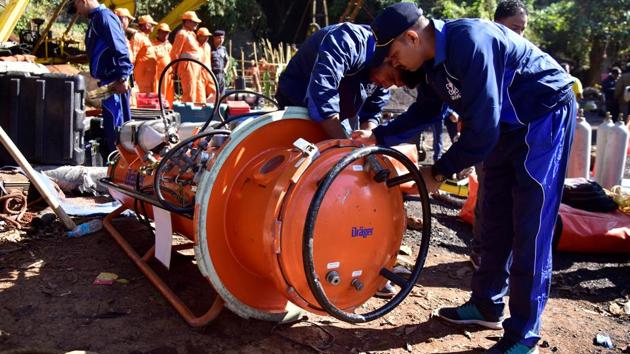Navy divers get inside Meghalaya coal mine; no trace yet of 15 trapped
A team of Indian Navy divers which entered the approximately 350 feet-deep shaft of the flooded rat-hole coal mine in Meghalaya, where 15 miners remain trapped since December 13, could not get to its bottom as it emerged that the NDRF had miscalculated the depth of water in it.
A team of Indian Navy divers who entered the approximately 350 feet-deep shaft of the flooded rat-hole coal mine in Meghalaya, where 15 miners remain trapped since December 13, could not reach its bottom as the NDRF seemed to have miscalculated the water level in it.

Santosh Kumar Singh of the National Disaster Response Force (NDRF) said that according to their calculation, the depth of the pit was around 320-350 feet and it was filled up with 70 feet water. They had hoped if the navy divers could manage to get to the bottom of the pit and discern how many lateral rat-holes there are, it would be a major breakthrough.
“The Navy divers went up to around twice the depth our divers were managing (30 feet) and still they could not get to the bottom of the pit,” he said.
“The water could be 125 feet deep. Navy will put equipment in the pit tomorrow to ascertain the actual depth of the water. We used improvised methods to ascertain the water could be 70 feet or more,” Singh said adding the pumping will begin tomorrow which will help in dewatering the tunnel.
After 16 days of procrastination and tardiness by the administration of Meghalaya, an 18-member team of the Indian Navy could finally commence its rescue operation at 1 pm on Sunday, when their equipment finally arrived.
The remote mine is a 1-1/2 hour drive and then a half-hour hike from the district headquarters of the East Jaintia Hills district. Only four-wheel-drive SUVs can navigate the three streams and the steep uphill dirt road that the last, two-kilometer stretch comprises of.
Before donning his diving suit, a navy diver told HT that his 18-member navy team has come equipped with diving sets, remotely-operated vehicles, re-compression chambers and other essential rescue gear.
“In these conditions, we can dive up to 45 meters (146.7 feet) but it will be dangerous for us to get into the rat holes at the bottom , because sharp edges can damage diving suits and air tubes and endanger the diver,” he said.
As a first step, an NDRF rubber boat was lowered into the shaft to serve as a platform for the diving team.
The rescue team from the Odisha Fire and Emergency Services could not start pumping out the water from the shaft. According to Odisha fire service chief Sukanta Sethi, the pumps can’t be started before divers go in because the pumps could fill the pit with smoke.
Also read | ‘How long can one hold his breath underwater’: Man who narrowly escaped Meghalaya mine flooding
There were some logistical issues too.
Tapan Kumar Mohanty, station officer, Odisha fire services said they have requested a carriage from the district administration on Saturday to help lower their pump inside the pit about 21 feet above the water, since it is not submersible. An official has said it will be arranged soon.
Ace diver Jaswant Singh Gill who brings experience in rescuing miners from flooded pits and has been contributing suggestions to the rescue teams, said that pumping out the water from the flooded mine is the foremost requirement.
Meanwhile, locals were reluctant to talk about coal mining. The senior district official said on condition of anonymity, that as much as 80 percent of the districts population is directly or indirectly connected to the activity, which was banned by the National Green Tribunal (NGT) in 2014.
On the road from the district headquarters to the rat-hole mines, the gentle slopes of the Jaintia Hills are dotted with heaps of coal and labourers loading it onto trucks.
“We don’t work on coal mines. It is the ‘outsiders’ who come and work. They do all these dangerous things,” said a local who had come to observe the rescue operation.






